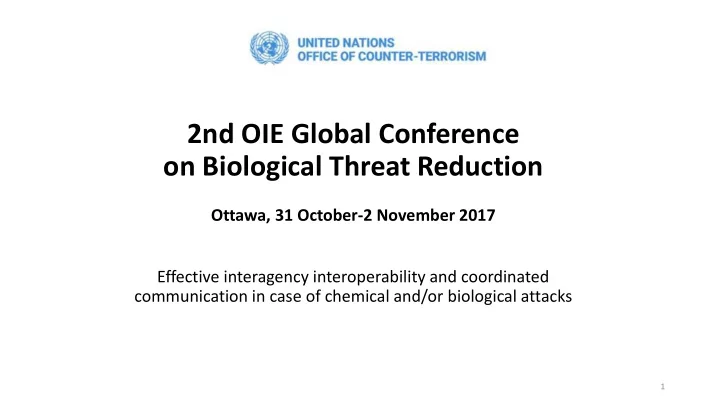

2nd OIE Global Conference on Biological Threat Reduction Ottawa, 31 October-2 November 2017 Effective interagency interoperability and coordinated communication in case of chemical and/or biological attacks 1
UNOCT • United Nations Office of Counter-Terrorism (UNOCT) established by General Assembly on 15 June 2017 • Counter-Terrorism Implementation Task Force (CTITF) Office and United Nations Counter-Terrorism Centre (UNCCT) subsumed to UNOCT • UN Global Counter-Terrorism Strategy • Working Group on Preventing and Responding to a WMD Terrorist Attack 2
Project overview • “Ensuring Effective Inter-Agency Interoperability and Coordinated Communication in case of Chemical and/or Biological Attacks ” • Pillar II of the UN Global Counter-Terrorism Strategy • Working Group on Preventing and Responding to a WMD Terrorist Attack (reports) • 19 participating agencies 3
Project goal Enhanced protection of and assistance to human communities in case of a biological or chemical attack by providing effective support to States , upon request, with response efforts when local capacities overwhelmed and/or need for specific technical expertise 4
Project objectives • Organized in two pillars • Pillar I: Ensure effective inter-agency interoperability in case of chemical or biological attacks • Pillar II: Ensure coordinated and effective communication during emergencies caused by such attacks 5
Phase I 2015 - 2016 • Kick- off Workshop , The Hague, the Netherlands, 19-20 February 2015 (OPCW) • Scenario-based Gap Analysis in current international cooperation arrangements and practices (mapping) • Common Understanding of Terms • Functional Focal Points (entry points) 6
Phase II 2016 - 2017 • Interagency Table-Top Exercise (TTX) , The Hague, the Netherlands, 18-20 January 2017 (OPCW with the support of Canada) • Cooperative tools • Key lessons and recommendations at the operational and policy/strategic level • Evaluation report of the TTX 7
Phase III 2017-2018 • Inception phase • Looking for co-funders • TTX and field exercise (based on Gap Analysis) • Cooperation with volunteer Member States : exercise engaging first responders 8
Mapping of roles 9
Recommendations I • Exchange of information and needs assessment 1) Exchange of information throughout the event 2) Explore possibilities to declassify information 3) Set up standing arrangements and other agreements among Agencies to simplify information exchange and cooperation 4) Maintain and further develop network of Functional Focal Points 5) Develop protocols for handling confidential information and for the collection and preservation of evidence for the Health sector 10
Recommendations II • Response 6) Map existing response resources 7) Develop and maintain a joint roster of skilled experts 8) Develop tasking check lists for team deployments covering such issues as equipment, transportation, assistance, etc., using UNDAC, GOARN, UNSGM, experience in Syria, etc. 9) For complex emergencies, explore deployment of multi-skilled joint advance teams for situational and needs assessment 10) Operations centers should converse regularly 11) Build on the OSOCC and UNDAC concepts for coordination in the field and use these where appropriate 11
Recommendations III • Response 12) Use the OSOCC reception and departure centers (RDCs) concept as a model to facilitate entry and exit of field teams. 13) In the context of investigations, coordinate interviews 14) Request the deployment and use of States’ MCDA to fill in capacity gaps on the ground (refer to OSLO and MCDA guidelines) 15) Liaise with WCO to facilitate contacts with national custom authorities 16) Agencies with capability in operating in CBRN environments, together with UNDSS, to advise other agencies lacking capability on the feasibility of operations, and make recommendations regarding appropriate preparations and precautions 12
Recommendations IV • Communication 17) Develop guidelines to coordinate joint communications to the public (i.e. information packets, FAQs, and talking points in various languages based using the IACRNE relevant SOPs as models) 18) Extend existing sectorial communication coordination mechanisms to other Agencies, possibly ad hoc for specific crises 13
Thank you http://www.un.org/en/counterterrorism/ 14
Recommend
More recommend